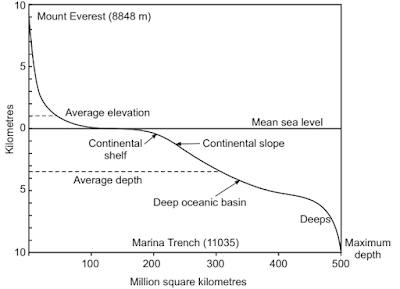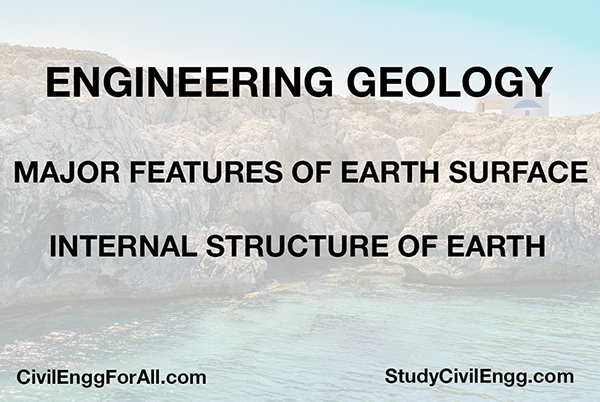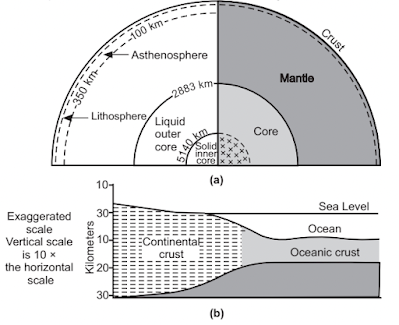MAJOR FEATURES OF EARTH SURFACE & INTERNAL STRUCTURE OF THE EARTH - ENGINEERING GEOLOGY (StudyCivilEngg.com)
MAJOR FEATURES OF EARTH SURFACE &
INTERNAL STRUCTURE OF THE EARTH
SUBJECT : ENGINEERING GEOLOGY
MAJOR FEATURES OF EARTH SURFACE
- The earth's surface is made of diversified features of limitless sizes and shapes which are classified into several orders on the basis of their scales. Features of the highest order are seen only with the help of satellite images or may be identified on the world map. These cover an area of several million square kilometres and are the products of internal earth processes, for example, continents, oceans, major mountain chains, rift valleys etc.
- Features of intermediate order cover an area of several hundred square kilometres. They are formed due to earth's external processes controlled by climatic conditions and also originated due to earth's internal processes, for example, San Andreas fault, river terraces, tectonic landforms etc.
- Features of the lower order can be easily recognised on aerial photographs or on topo sheets having a scale 1: 25,000, for example, a meandering steam, soil horizons etc. The features of different orders are summarised in below table
- From the above table, it can be said that the features are prominently formed due to the earth's internal and external processes. The external processes can be visualised by considering weathering erosion and deposition caused by the work of natural agencies including running water, wind, glaciers and sea. The internal processes may be explained with the concept of plate tectonics, the most important discovery in the 20th century.
- The major features of the earth show that about 71% of the earth's surface is covered by oceans and their average depth is 3800 metres. The depth is extremely variable and maximum depth, 11035 metres, is recorded at Mariana Trench, in the Western Pacific. (From below figure).
- The remaining 29% of the earth's surface is occupied by land. It has an average elevation of 800 metres above mean sea level. The surface of continents is constantly modified by weathering and erosion. Thus, the surface morphology is dissected in a very complicated manner. The maximum elevation, 8848 metres, is recorded at Mount Everest, Nepal.
 |
| Hypsographic Curve |
- Modern coastal lines do not coincide exactly with the boundaries between continental and oceanic crust. The boundaries are covered by oceanic water and the present day boundaries are actually all the continents. Thus, each continent is surrounded by a gently dipping continental shelf. With the changes in slope, continental shelf passes into continental slope, which may be considered as a bottom of continental surface. If we take this as a boundary of the continents, then it is estimated that about 60% of the earth's surface is occupied by the oceanic basins while the remaining 40% is covered by continents. Thus, 10% of the continental crust is occupied by oceanic water.
- The continental rise lies at the base of continental slope. It is a region of gently changing slope where the floor of oceanic time, which cannot be studied in the laboratory. One must also understand limitations of the study. The surface exposures can be studied in greater details with satisfactory results. The same can be said of shallow sub-surfaces studies.
- However, deeper sub-surface studies are to be carried out with the help of geophysical methods. In this, the information received is in the form of magnetic, and electric properties of rocks, velocity of sound waves etc. In other words, interpretation of this information varies from person to person. Hence, the same information may be interpreted in different ways by different persons producing heterogeneity in the results.
INTERNAL STRUCTURE OF EARTH
- Planet earth contains three compositional layers. At the centre is the dense most of these three layers, the core. The core is a spherical mass, composed mainly of metallic iron, with minor amounts of nickel and other elements.
- The thick shell that surrounds the core is called the mantle. It is less dense than the core, but denser than the outermost layer. Above the mantle lies the thinnest and outermost layer, the crust
- It is seen from below figure that the core and mantle have almost uniform thickness. However, the crust differs in thickness from place to place. The crust beneath oceans known as oceanic crust, has an average thickness of 8 kilometres, while continental crust has an average thickness of 45 kilometres. It shows variation in thickness from 30 to 70 kilometres
- In addition to compositional layering, other changes including changes in physical properties also occur within the earth. These are largely controlled by temperature and pressure, rather than rock composition. The places where changes in physical properties do not coincide with the compositional boundaries, are shown in below figure
- Within the core exists an inner region where iron is interpreted to be in solid state despite of very high temperature. This solid centre of the earth is called inner core. It is believed that the solid state of the iron is due to presence of very high pressure. Surrounding inner core is a zone of outer core where temperature and pressure are balanced in such a way that iron is molten and behaves like a liquid.
- Similarly, difference in temperature and pressure divides the mantle and crust into three distinct regions: the mesosphere, the asthenosphere and the lithosphere. (Figure (a)).
- In the lower part of the mantle, the rock has a considerable strength despite of very high temperature (from 2883 km to 350 km). This solid region of high strength and temperature is called the mesosphere (intermediate or middle sphere).
- Within the upper mantle i.e. from 350 km to about 100 km, is a region called the asthenosphere (weak sphere). Here the rocks are weak and easily deformed like butter.
- Above the asthenosphere, i.e. the uppermost region of 100 km, is called the lithosphere (rock sphere) where rocks are cooler, stronger and rigid than plastic asthenosphere. The lithosphere is not a homogeneous continuous layer. Instead it is broken into a number of larger or smaller plates.
FAQs COVERED IN THIS POST
Features of Earth Surface
Earth Surface
Internal Structure of Earth
Hypsographic Curve
RELATED POSTS
- SURVEYING - STUDY ONLINE
- BUILDING MATERIALS AND CONSTRUCTION - STUDY ONLINE
- FLUID MECHANICS - STUDY ONLINE
- SOIL MECHANICS - STUDY ONLINE







Post a Comment